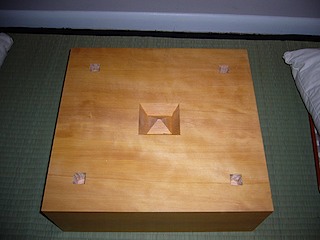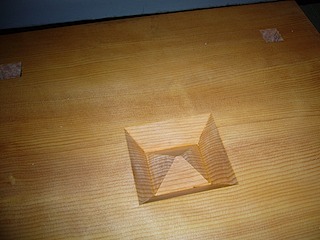

Source: Favebeans78
The traditional goban will usually have its underside carved with a pyramid called a heso recessed into the board. Tradition holds that this is to give a better resonance to the stone's click, but the more conventional explanation is to allow the board to expand and contract without splitting the wood. In theory, the wood never fully dries, so fully sealing it threatens warping in varying conditions. The heso allows the board to breathe. Source: The Trading Centre
Do you think there is much more explanation than this ? I have seen traditional floor goban with that has recess without the pyramid.
Here an interesting story from Janice Kim's Samarkand site :
Turn a traditional thick Go floor board like this one upside down and you'll notice a pyramid, chiseled out of wood, sunken in a square well. What's it for?
One theory is that it improves the resonance and tone of the board when a stone is rapped on its surface. Japanese folklore has it that the well served to hold the blood of kibitzers who were unwise enough to blurt out advice aloud during a game and were beheaded on the spot.
Novelist and artist Brian D'Amato has speculated the legend may be an "occluded memory" of a time when the ancestor of the Go board itself was a pyramidal altar used for pessomancy- divination by pebbles- and, possibly, for blood offerings from live sacrifices. What do you think?
毘 (?) : help, assist; connect, adjoin (it has the same meaning in both Chinese and Japanese kanji)
